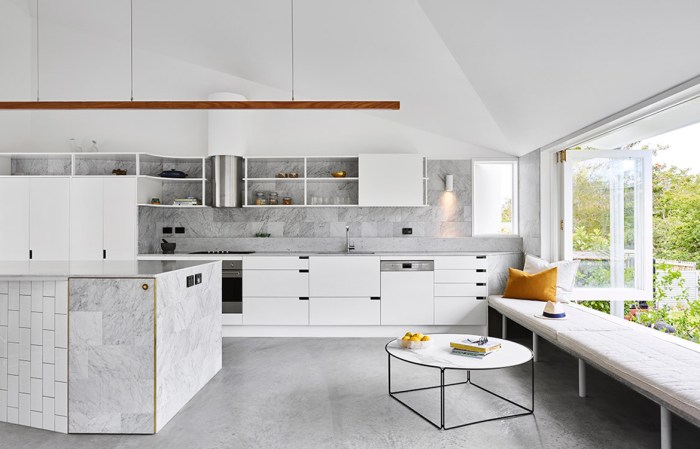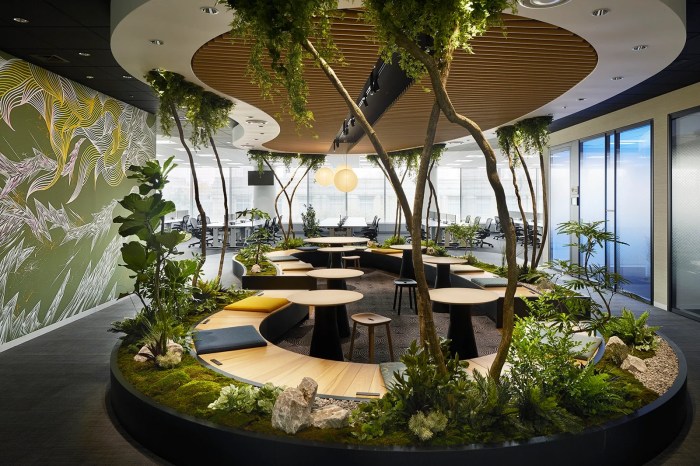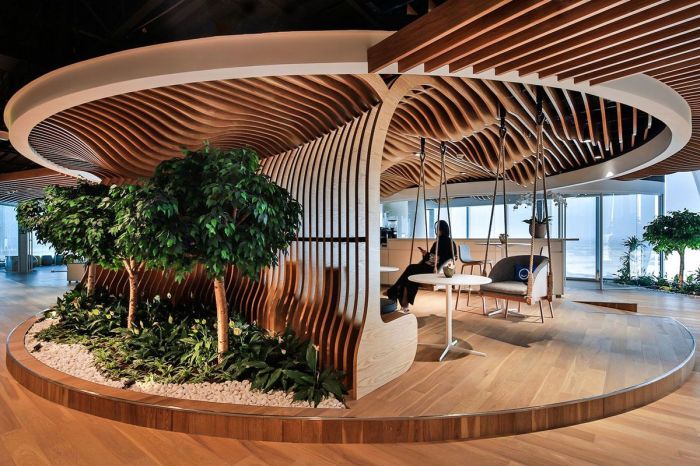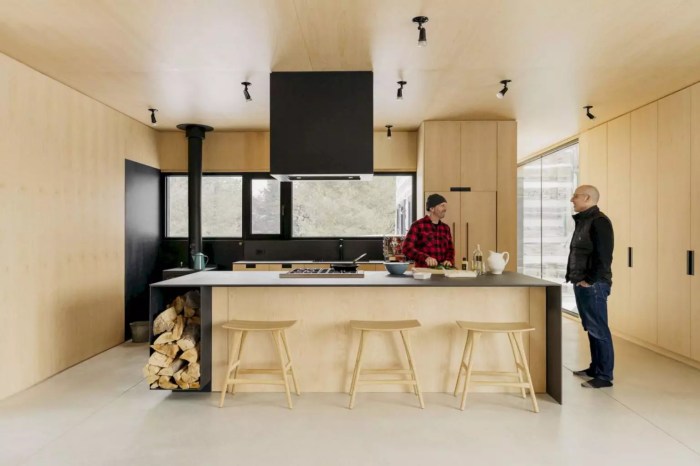Incorporating Biophilic Design in Your Modular Kitchen Space: A Guide to Creating a Nature-Inspired Haven. In this guide, we will delve into the transformative power of biophilic design, exploring how to seamlessly integrate natural elements into your modular kitchen space, fostering a sense of well-being, creativity, and connection with the natural world.
Biophilic design, rooted in the innate human desire for connection with nature, has emerged as a powerful tool in shaping spaces that positively impact our physical, mental, and emotional health. By incorporating biophilic elements into your modular kitchen, you can create a space that not only serves as a functional cooking area but also becomes a sanctuary for rejuvenation and inspiration.
Biophilic Elements in Modular Kitchen Design

Biophilic design seeks to connect humans with nature within built environments. Incorporating biophilic elements into modular kitchen spaces can create a healthier, more comfortable, and more inspiring environment.
Biophilic elements that can be incorporated into a modular kitchen space include:
- Natural materials, such as wood, stone, and plants, can bring the outdoors in and create a sense of warmth and comfort.
- Natural lighting can improve mood, increase productivity, and reduce eye strain.
- Ventilation can improve air quality and reduce the risk of respiratory problems.
- Views of nature can reduce stress, improve concentration, and boost creativity.
- Water features can add a sense of tranquility and calm.
By incorporating these biophilic elements into modular kitchen design, you can create a space that is not only functional but also healthy and inspiring.
Creating a Sense of Connection with Nature

Incorporating biophilic design principles in your modular kitchen space extends beyond the mere presence of plants. It involves creating a deep connection with nature through visual and sensory elements.
One key aspect of this is establishing a visual connection to the outdoors. Large windows and skylights allow natural light to flood the space, reducing the reliance on artificial lighting and providing a sense of openness. Strategic placement of these windows can frame outdoor views, bringing the beauty of nature into the kitchen.
Natural Elements
Bringing the outdoors inside through natural elements is another powerful way to foster a connection with nature. Plants, with their vibrant colors and textures, purify the air and create a calming atmosphere. Water features, such as a small fountain or aquarium, add a soothing touch and evoke a sense of tranquility.
Biomorphic Shapes and Patterns
Biomorphic shapes and patterns, inspired by organic forms found in nature, can evoke a subconscious connection with the natural world. Curved lines, rounded edges, and organic textures mimic the shapes of plants, animals, and landscapes, creating a sense of familiarity and comfort.
Designing for Sensory Stimulation
Sensory stimulation is crucial for creating a captivating and engaging kitchen space. Incorporating elements that stimulate the senses of sight, sound, touch, smell, and taste can elevate the overall experience, making the kitchen a place of comfort, inspiration, and joy.
Auditory Elements, Incorporating Biophilic Design in Your Modular Kitchen Space
Auditory elements can significantly impact the atmosphere of a kitchen. The sound of running water from a faucet or a kettle can create a soothing and calming effect. Incorporating nature-inspired sounds, such as birdsong or the rustling of leaves, can bring the outdoors in and create a sense of tranquility.
Tactile Elements
Tactile elements add depth and character to a kitchen space. Using textured surfaces, such as wood grains or stone countertops, provides a tactile experience that engages the sense of touch. Natural fabrics, like cotton or linen, can add warmth and softness to the space.
Olfactory Elements
Scents have a powerful ability to evoke memories and emotions. Incorporating fresh herbs or citrus fruits into the kitchen design can create a stimulating and inviting atmosphere. Using essential oil diffusers or scented candles can also enhance the sensory experience and promote relaxation or invigorate the senses.
Improving Air Quality and Thermal Comfort
Incorporating biophilic elements into your modular kitchen space not only enhances its aesthetic appeal but also contributes to a healthier and more comfortable indoor environment. Here’s how you can improve air quality and thermal comfort in your kitchen:
Natural Materials and Finishes
Choosing natural materials and finishes, such as wood, stone, and bamboo, promotes good air quality. These materials emit fewer volatile organic compounds (VOCs) than synthetic materials, which can contribute to indoor air pollution.
Plants
Plants are natural air purifiers. They absorb toxins and release oxygen, improving the air quality in your kitchen. Additionally, plants help regulate humidity levels, which can make the space feel more comfortable.
Passive Design Strategies
Passive design strategies, such as cross-ventilation and solar shading, can improve thermal comfort and reduce energy consumption. Cross-ventilation allows for natural air circulation, which helps regulate temperature and humidity levels. Solar shading, such as awnings or blinds, can block out direct sunlight, reducing heat gain in the summer and saving energy on cooling costs.
Case Studies and Examples

Biophilic design has gained immense popularity in modular kitchen design, with several successful examples showcasing its transformative impact. These designs demonstrate the effective incorporation of natural elements, sensory stimulation, and improved air quality, leading to enhanced user experiences and well-being.
One notable example is the “Nature’s Embrace” modular kitchen by a renowned design firm. This kitchen features a seamless integration of natural wood finishes, large windows that provide ample natural light, and indoor plants strategically placed to create a sense of connection with the outdoors.
The use of organic shapes and textures, such as a curved island countertop and woven pendant lights, further enhances the biophilic aesthetic.
Design Elements and Strategies
The success of biophilic modular kitchen designs lies in the thoughtful implementation of specific design elements and strategies. These include:
- Natural Materials:Using materials like wood, stone, and bamboo brings warmth and texture to the kitchen, evoking a connection with nature.
- Natural Lighting:Maximizing natural light through large windows or skylights creates a bright and airy space that promotes well-being.
- Indoor Plants:Incorporating plants into the kitchen not only adds a touch of greenery but also purifies the air and reduces stress levels.
- Biomorphic Forms:Designing kitchen elements with organic shapes, such as curved countertops or rounded cabinets, mimics natural forms and creates a more inviting space.
- Sensory Stimulation:Engaging multiple senses through the use of natural scents, textures, and sounds enhances the overall user experience.
Positive Impact on User Experience
Biophilic modular kitchen designs have a profound impact on user experience and well-being. The incorporation of natural elements and sensory stimulation creates a more relaxing and restorative environment, reducing stress and improving mood. Additionally, improved air quality and thermal comfort contribute to overall health and productivity.
Epilogue

Embracing biophilic design principles in your modular kitchen space offers a multitude of benefits, enhancing not only the aesthetics but also the overall user experience. By incorporating natural materials, maximizing natural light, and introducing elements that evoke a connection with nature, you can create a space that nourishes your well-being, stimulates your senses, and fosters a deep appreciation for the beauty of the natural world.
As you embark on this journey of transforming your kitchen into a biophilic haven, remember that the key lies in finding a harmonious balance between functionality and nature, creating a space that is both aesthetically pleasing and deeply connected to the rhythms of the natural world.
FAQ Overview: Incorporating Biophilic Design In Your Modular Kitchen Space
What are the key principles of biophilic design?
Biophilic design focuses on incorporating natural elements, patterns, and processes into built environments to enhance human well-being. Key principles include maximizing natural light, using natural materials, introducing plants and water features, and creating visual connections to the outdoors.
How can I incorporate biophilic elements into my modular kitchen space?
Consider using natural materials like wood, stone, and bamboo for cabinetry, countertops, and flooring. Introduce plants to purify the air and add a touch of greenery. Maximize natural light through large windows or skylights, and create visual connections to the outdoors with views of nature.
What are the benefits of incorporating biophilic design in my kitchen?
Biophilic design has been shown to reduce stress, improve mood, enhance creativity, and boost overall well-being. In the kitchen, it can create a more inviting and inspiring space for cooking, dining, and socializing.
